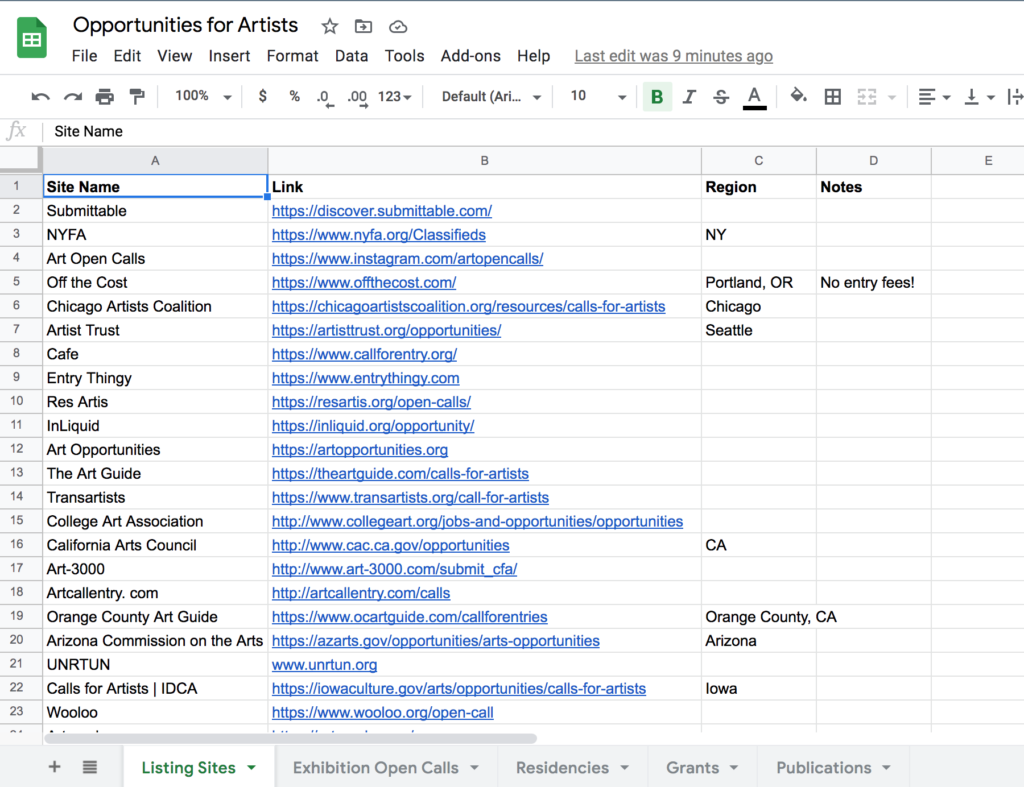Here are some tips for submitting your work, which I’ve learned as an artist, curator, and from colleagues and friends. I also talked about this on instagram live, which you can see here.
- Be selective in where you apply. Figure out your goals for your art career and think about how each opportunity fits into those goals. If open calls have high fees, consider your return on the investment. It might be worth the fee to get your work in front of a certain curator or to have a chance at a monetary prize or publication… or it might not be worth it. Make those decisions with your longer term goals in mind and try to take the emotions out of it. I often consider whether I’d be happy to donate the fee amount to the space/organization/project. If not, I won’t submit. I shared a spreadsheet of opportunities and listing sites here.
- Set a goal for rejections. This is a great mindset shift I learned from Erin McCluskey Wheeler! Set a goal of getting 50 rejections per year (or whatever number makes sense to you). Then celebrate each rejection. You put yourself out there! A curator saw your work! You’re that much closer to another acceptance letter.
- Follow instructions carefully. If it asks for 300 words, don’t submit more than that. If it asks for images labeled with your name and the title, rename your images appropriately.
- The images are queen! Usually initial decisions are based solely on your images. Make sure they shine. Crop images to show only the artwork, avoid blurry images, get good consistent lighting. If possible, get professional photos taken of your work. If that isn’t possible, there are tons of resources online about improving your artwork photography. Here’s one.
- A bio is different from a CV or a statement. A bio should be in sentences and paragraphs, not bullets. It’s typically written in the 3rd person and includes relevant biographical info about you as an artist.
- Adjust your artist statement slightly for each call. This may simply mean adjusting the length. I have several versions saved at varying lengths and related to different bodies of work. It can also be helpful to add a sentence or two explicitly outlining how your work fits the theme of the call (for thematic calls). My statement is always a work in progress. Here’s some great advice on statements from Artwork Archive.
- Title your image files with your name, image title/number, etc, or whatever the instructions say (the actual image, not just on the form). In our forms, image files are saved separately, so it can be difficult to sort out which images are which if they’re not titled (and not every curator/coordinator will be able or willing to take the time to sort things out).
- Include as many images as allowed! Give curators several options to choose from and help them see your vision through a series of work.
- Be consistent. Show images from the same series. This looks more professional and may result in multiple images being selected for a show. If your work ranges widely, choose a body of work that fits each call.
- Resize your images so they upload properly (for us, no more than 5mb, but each call has different specifications).
- Reach out with questions. If you have questions or technical issues, reach out to the curator/coordinator! Do so kindly, show respect for their time, and have patience and you’ll likely get a helpful response.
Tips for Staying Organized and Saving Time:
- Track upcoming calls. I have a google spreadsheet where I track calls that I’m applying to or considering applying to. I also track whether I applied and whether I was accepted. This helps me not only plan ahead for applications, but also budget for submission fees and see my success rate. Here’s a blank version, which you can make a copy of and add your own information.
- Don’t reinvent the wheel. Save a few versions of your statement and bio that you can re-use for submissions. I have versions that are short (1 sentence, 100 words), medium (200-300 words), and long (full page, 500-700 words). I also have statement versions for each series as well as an overall statement. Depending on the work submitted and the requirements of the show, I can pull something I’ve already written and maybe tweak it slightly without spending a lot of time writing for every submission.
- Store your files logically. It’s been very helpful to me to store my submission files in their own folders for a few reasons: I can prepare files ahead of time to fit the requirements of each call, I easily find and re-use files, I can see what was successful, and I can find info if requested when accepted. I have a “submissions” folder to store submissions. Inside this folder there are 2 folders: “submitted” and “upcoming”. Within “upcoming” I have a folder for each open call or application where I store copies of the images renamed to fit the instructions for that particular call. I also save any documents or writing that are specific to that call. After I submit, I move that folder into the “submitted” folder. Inside “submitted” are 3 more folders: accepted, pending, and rejected. This is just what works for me – figure out what works for you!



